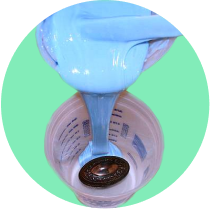
LifeRite Skin Safe Silicone for Life Casting
NEW! Skin-safe silicone RTV ideal for life casting. 10:1 Mix ratio. Make reusable molds the first time.
- Life casting and body casting
- Prosthetics
- Special Effects
Typical Properties as Supplied :
Part A Base-Component Part B Catalyst
-
Color White Color Purple
-
Consistency Thixotropic Viscosity, cP. (mPas)
-
Viscosity, cP. (mPas)
TECHNICAL SPECIFICATIONS
Stir the base (Part A) well before use (except when machine dispensing).
Shake the catalyst container (Part B) well before use.
Weigh the desired amount of base into a clean mixing container. Tip the container and roll the base all the way around the sidewall up to two inches from the top. This will prevent the catalyst from becoming absorbed into the container.
Weigh the proper amount of catalyst into the container. Mix the base and catalyst together by stirring with a stiff, flat-ended metal spatula until a uniform color is obtained. Scrape the container walls and bottom well to insure a thorough mix.
The Next Steps will eliminate all air bubbles, but is not necessary as LifeRite will set with minimum of air bubbles since both Parts A & B have been de-aired at the plant and application is made by brush rather than pouring.
Create a print coat by mixing LifeRite with 10% silicone oil by weight.
Apply the material using a soft bristle brush, palette knife or spatula. The brushing motion and the more viscous 'print' layer should eliminate most air bubbles.
Mix the 'back-up' per directions with no silicone oil and apply. The final mold thickness should be about ¼-1/2-inch (1 cm). LifRite will stick to itself so that thinner areas can be built up with additional LifeRite is needed.
Allow the rubber to cure for 5-6 minutes or so before applying the support shell.
Allow the mold to cure an additional 60-minutes before casting after removal or pin-hole air bubbles may form in your casting.
PROCESSING INFORMATION
CATALYZED PROCESSING PROPERTIES ARE AFFECTED BY TEMPERATURE AND HUMIDITY VARIATION
For best results, mix and cure the material at 72°F (23°C) and 50% relative humidity.
Higher temperature and humidity will decrease the work life and pot life of the material. The faster cure will also affect the flow properties. Refrigeration of the base prior to use in hot environments has shown to improve the handling properties of this material.
Lower temperatures and humidity will increase the work life and pot life of the material. The slower cure will increase the flow time. Cure temperatures below 68°F (20°C) are not recommended and have been found to cause a reduction in final cure hardness and properties.
It is important that the catalyst containers are tightly closed after use. Catalyst exposed to air for extended periods of time will hydrolyze (cure). An indication of hydrolysis is a film or crust formation on the surface of the catalyst. The use of hydrolyzed catalyst is not recommended and may cause incomplete cure.
Safety Preautions
USE MATERIAL IN ACCORDANCE WITH MATERIAL SAFETY DATA SHEET












